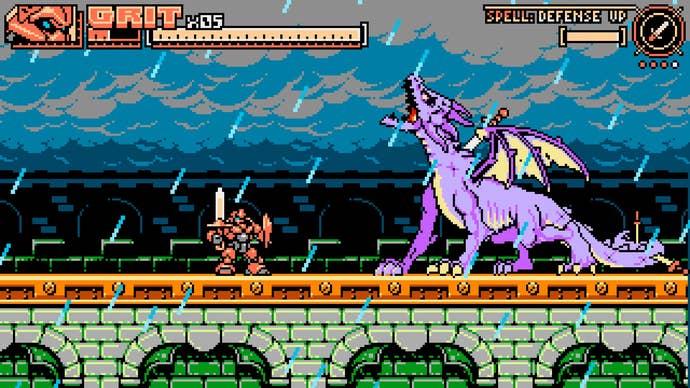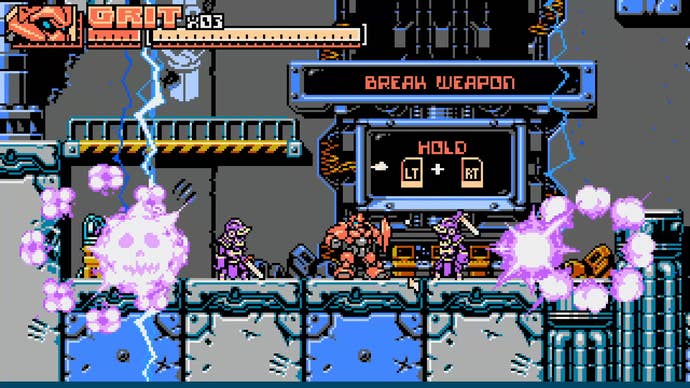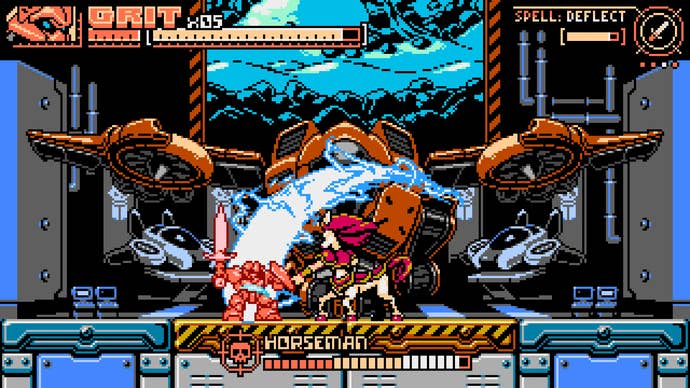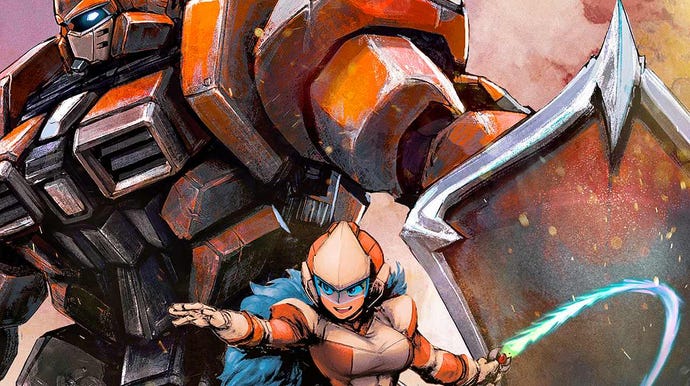Panzer Paladin Review: A Lovable Retro Hero Rolls to the Rescue
Inside every great robot hero, there's a tiny robot woman with a big whip.
This article first appeared on USgamer, a partner publication of VG247. Some content, such as this article, has been migrated to VG247 for posterity after USgamer's closure - but it has not been edited or further vetted by the VG247 team.
Most indie games inspired by the retro titles of yore are based primarily on one specific franchise. For example, 20XX is styled to resemble Mega Man. Stardew Valley is (very successfully) styled to resemble Harvest Moon. And many indie RPGs—maybe too many—are built on Earthbound's whimsical foundation.
Panzer Paladin is yet one more indie platformer to model itself off the childhood classics that remain beloved to '80s and '90s kids, but it goes whole hog. Seemingly every minute of gameplay is bundled with a tribute; recognizing them all almost gave me whiplash. "That's a reference to Blaster Master," I cried out. "That's a reference to Mega Man! That's a reference to The Adventure of Link!" And so on.
Thankfully, Panzer Paladin's great big retro stew is a tasty dish. Its ingredients work well together, and I left the table feeling full and happy, even if there were points where I wished it had a little more spice. Panzer Paladin is a great retro action game, but its platforming physics occasionally feel heavy and frustrating, among other issues.
Panzer Paladin is set on an alternate Earth that's been invaded by demonic forces. Mythological figures like Lilith, Baba Yaga, Pazuzu, and other dark servants armed with evil weapons strut around the world map. The planet's only hope is a cyborg named Flame and her Paladin-class mech-suit, Grit. Together, they set out to cleanse earth's countries of its dastardly squatters.
Panzer Paladin's inspirations are many and obvious, but 1988's Blaster Master for the NES is first and foremost. Blaster Master is primarily played from the seat of the Sophia the 3rd tank, but its pilot, Jason, can exit to explore areas his vehicles can't reach. The same holds true for Panzer Paladin. Most of the game is spent controlling Grit, but Flame can eject whenever she likes—and she's forced to eject whenever Grit takes too much abuse and runs out of energy.
Flame is adorably tiny, which makes her nimble. She can scuttle into small passages and use her Belmont-style whip to defeat enemies and swing from hooks. However, she can't take too many hits before she, too, succumbs. She also can't pick up the myriad weapons Grit can arm itself with. This makes sense: said weapons are several times larger than she is.

Grit's weapons are a big reason why Panzer Paladin feels good to play. They're everywhere: you can gather them up from defeated enemies, from behind broken walls, and from the bosses, who drop legendary goods. At one point, my collection included everything from Anubis' own staff to a hockey stick. (Developer Tribute Games is in Montreal.) You don't hang on to any of your weapons for long, however. Most of them break after you give the bad guys a few good whacks.
No doubt a few fans of The Legend of Zelda: Breath of the Wild went a little pale after reading that. "Breakable items bad" versus "Breakable items good, actually" is always a hot debate topic. But Panzer Paladin adds value to its breakable weapons system by making them a key part of the game's strategy. Every weapon contains "Spirit Energy" that's released when the player chooses to snap a weapon in half. Breaking a dirk might give you a boost in power, and breaking a falchion might increase your defense. Some weapons release enormous damaging spells when they break, and others will heal Grit. These weapons are supremely valuable, since opportunities to heal Grit are limited in Panzer Paladin.
Ideally, players should keep an eye on their weapon's durability, then release its Spirit Power at the last possible second. Strike a foe one too many times, and the weapon breaks but the Spirit Power is lost forever. Break a weapon too early, and it can be a waste of a strong or rare item. Still, that early release might be necessary if Grit is in dire need of healing. It's surprising how much of Panzer Paladin's strategy relies on making split decisions in the heat of battle.

Those battles are undoubtedly my favorite part of Panzer Paladin. Grit slices through waves of alien mooks that die in one shot, but he also goes up against a lot of well-armored hench monsters who know how to use a sword and shield. These enemy knight battles bear a strong resemblance to the "Ironknuckle" knights in 1987's Zelda 2: The Adventure of Link, which deflect Link's sword attacks and counterattack relentlessly. Grit's huge store of weapons comes in handy when he's up against these particularly vicious foes, as does his freedom of movement: he can stab upward as well as downward, which is another shout-out to The Adventure of Link.
Boss fights are similarly intense. Each mythological figure has its own means of attack, and some of them hit very hard. Magic-users like Baba Yaga and Furfur gave me an especially hard time, because they use trickery to clone themselves, call up reinforcements, and perform other frustrating acts. To hell with magic users.
When playing through Panzer Paladin, at some point it becomes clear each weapon that's wrenched from a boss is meant to be used against another boss. There is a Mega Man-esque "Rock, Paper, Scissors" mechanic at work that is supposed to make enemies that wield one type of weapon susceptible to damage from another type. To be honest, I never figured it out. I just flicked between my weapon stock and took note of which weapon did the most damage.

One of Panzer Paladin's flaws is that it's vague at times. The unexplained weapon triangle is one problem, and I was also left wondering about the consequences of collecting too many Spirit Weapons. As was already explained, weapons are plentiful, and extras can be used to extend Grit's health bar in between levels. I still accumulated enough weapons to get a warning about being exposed to "Too much Spirit Energy," but nobody told me about potential consequences.
As far as I can tell, carrying all those Spirit Weapons didn't hurt my attack or defense. I believe their presence did summon a mysterious horse-man who sometimes appears at intervals to fight with you. Said horse-man seems compelled to fight because he's worried about Grit and Flame becoming corrupted, a fate that befell another Panzer and cyborg team in the past. It's all fun stuff that nods at cheesy NES cinemas from games like Ninja Gaiden and Mega Man 3. Maybe Tribute Games purposefully made certain mechanics vague to really shine a light on Panzer Paladin's NES roots. (We still had instruction books, though.)
Panzer Paladin's platforming is also problematic from time to time. Fighting enemies feels great; jumping on platforms across perilous pits, less so. Grit has a heaviness that calls back to NES-era Simon Belmont, which makes his jumps inelegant. I was cheated out of jumps that I was certain I made, which is a touch frustrating when a game features long levels with tricky platforming sequences and few checkpoints.

Panzer Paladin's story mode also utilizes a life system, which I'm not excited about. Lives feel like an archaic mechanic that artificially inflates difficulty. Send me back to my checkpoint if you must, but don't force me to watch those useless numbers count down until they hit zero and slam the action into a brick wall.
Nevertheless, every new level is a reminder why it's hard to stay mad at Panzer Paladin. Like Shovel Knight by Yacht Club Games, it nails the authenticity of the popular "NES tribute" style.. Tribute Games's decision to pluck a little bit of influence from a handful of 8-bit classics also could've wound up as a lesson in how "too many witches spoil the brew," but it all mixes nicely despite occasional platforming flaws, some vague instructions, and the tired lives system.
There are still tons of modern touches, most of which are implemented with expert subtlety. I look at Panzer Paladin and see Konami's color palette, Capcom's creative enemy design, and Sunsoft's attention to animation. Panzer Paladin is a great retro romp, and I'd love to see a sequel. I'm down to hang out with weapon-wielding mecha any time, anywhere.
ConclusionPanzer Paladin adopts a bit of every NES platformer you played as a kid, and the result is a little chaotic, but a lot of fun. Panzer Paladin's degradable-weapon mechanic adds a unique element of strategy to the mix, and playing as Flame outside of her Panzer suit lets you discover some cool secrets. However, there are times when the instructions are vague and the lives system doesn't need to exist in this day and age, but it's hard to stay mad when you're surrounded by this much 8-bit beauty.










